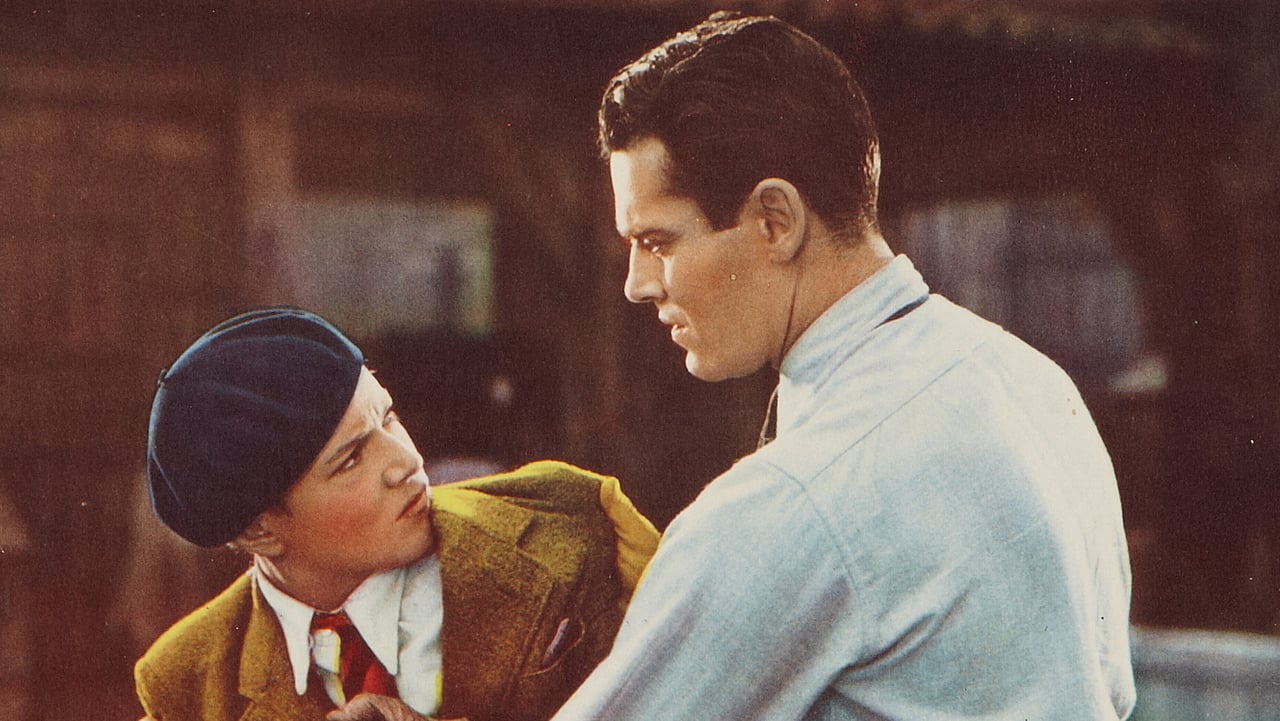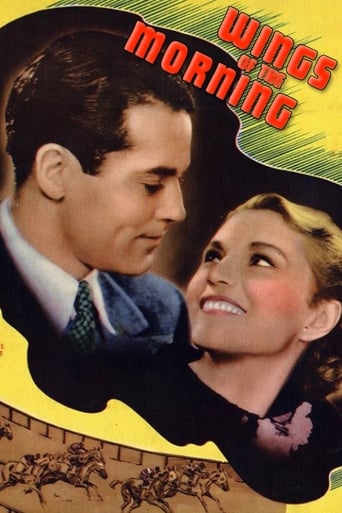



Don't Believe the Hype
Absolutely brilliant
There's a more than satisfactory amount of boom-boom in the movie's trim running time.
View MoreThrough painfully honest and emotional moments, the movie becomes irresistibly relatable
View More"Wings of the Morning" (1937) has the distinction of being the first Technicolor film shot in the British isles, made when the great cinematographer Jack Cardiff was operating a camera. It also introduced the Irish tenor John McCormack to the public. Wings of the Morning might have been important for being French actress Annabella's first English-speaking film, but Annabella was two years away from becoming very famous for another reason which basically stopped her film career.Annabella has a dual role here, actually a triple role, in a film that takes place first in the 1800s and then in the present day. First, she is Marie, a gypsy, who is with other gypsies in Ireland in 1869. The Lord Clontarf (Lesley Banks) gives the gypsies rights to live on his land in perpetuity. He falls in love with Marie and the two marry, a union that is definitely controversial. When Lord Clontarf is killed in a fall while riding, Marie jumps on the gypsy caravan, and ever the roamers, they leave the area.Fifty years later, Annabella plays Maria, Duchess of Leyva, who is Marie's great-granddaughter and engaged to Don Diego (Teddy Underdown). The gypsies must flee Spain due to a revolution, so they return to the Clontarf land in Ireland. Marie (now played by Irene Vanbrugh) is worried that Maria will not get out of Spain, but she does, dressed as a boy. While so dressed, she meets horse trainer Kerry Gilfallen (Fonda), a Canadian. Eventually he discovers he's a she and falls for her. Maria has traded her great-grandmother's horse, Wings of the Morning to Kerry, not realizing the importance of the animal. Marie intends to enter it in a race in order to win money for Maria's dowry.Henry Fonda was such a handsome young man, and always a good actor, but he doesn't come off as Canadian with that drawl of his. Despite being new to English, Annabella does a very effective job in all of her roles - she was, after all, a huge star in France. Singer John McCormack had a beautiful Irish tenor, but what a bore - no career in movies for him.As far as the film itself, it's an interesting story but in the end, not a great film. The color isn't as sharp as we're used to today, but it doesn't diminish the incredible beauty of the Irish countryside.Annabella met actor Tyrone Power on the set of Suez in 1938 and the couple married in 1939. Their boss, Darryl F. Zanuck, did everything he could to break them up -- he offered Annabella some films that were to be made in Europe -- but she refused to leave Power. Once they married, the star buildup for Annabella stopped. She would star on Broadway, work for the war effort, do radio, and a production of "Liliom" with her husband, finally returning to France after they were divorced in 1948. From what she said in interviews -- je ne regrette rien.
View MoreThis is the first full-length Three-Color Technicolor films made in the British Isles. Because of this, you might have imagined that it would be a particularly good film. Well, like the first full-length American film made using this process, Becky Sharpe (1935), it's no classic. Three-Color looks like true color (more or less), as previous attempts (such as the company's Two-Color process) were less than terrific."Wings of the Morning" starts with a completely ridiculous and improbable prologue. A group of gypsies are camping out on the land belonging to an Irish lord. Instead of throwing them off the land, though, the lord is swell and lets them stay. He also soon falls in love with one of the gypsies and marries her. Sadly, however, he dies in an accident shortly after the wedding and she is subsequently forced by his family to leave the country for Spain.The story picks up half a century later. The Spanish Civil War is raging and the widow now decides to return to Ireland with her granddaughter (Annabella--who, oddly, has a French accent). There, Annabella meets Henry Fonda in one of the most annoying 'meeting' scenes I can recall (ooo, it's bad). He thinks she is a boy--I just think she was behaving in a boorish manner. It's supposed to be cute and funny...it isn't. Regardless, the cliché says that after such an inauspicious meeting that they'll soon fall in love. And, speaking of clichés, Annabella seems to be a walking cliché--headstrong, unreasonable and yet waiting to be tamed by Fonda (oh, brother). Much of the rest of the film consists of Fonda repeatedly about to take off his clothes in front of the prudish Annabella until he ultimately figures out she's a girl and they fall in love.Of course, since it's only halfway through the film, you KNOW that some glitches must come to threaten their love. First, Don Diego, who was pledges to the Gypsy years ago now returns. Second, there is the 'big race'--neither of which is particularly interesting since you have known for most of the film what would ultimately happen by the end. Overall, despite some nice scenery, a clichéd film that didn't do much for me. The characters seemed clichéd and predictable from start to finish.By the way, Henry Fonda should NOT sing in films. A fine actor, yes. A singer, good grief, no! As for Annabella, well, perhaps she could act but given this sort of drivel, it's sure not apparent in this film.
View MoreThis is the first true technicolor feature to be made in the UK. The story concerns a beautiful young Spanish gypsy woman (French actress Anna Bella) who flees to England where she falls in love with a Canadian horse trainer (Henry Fonda) against a back drop of the UK's premier horse race, The Derby.The story is a bit unoriginal and the dialogue extremely clunky in places. There is also an element of tweeness to the depictions of gypsy life. Yet despite the so-so plot and (at times) wooden acting there is a certain charm in the film. The Technicolor photography is gorgeous and it provides a very rare colour record of what England & Ireland looked like prior to the second world war. The scenes on Epsom downs are also remarkably well filmed (considering the technical limitations of early technicolor filming on location) and the colour really brings an otherwise very average film to vivid life. There are one or two moments which would make the politically correct viewer squirm, such as the depiction of black & white minstrels.If this film had been made in black & white i suspect it would have been long forgotten now, but as a curio it is a fascinating insight into another era. The photography is beautiful at times and make the film watchable. If only the same care had been taken with the script. Its a shame that this DVD only seems to be available in the U.S. though as i think it is calling out for a decent release.
View MoreShot partially on location in Killarney, Ireland in Glorious Three-Strip Tecnicolor, "Wings of the Morning" can claim to be the first film shot in that process on the British Isles. Iconic cinematographer Jack Cardiff gets his first Technicolor credit as the film's camera operator and would go on to one of the most illustrious careers in film history. However, although it was financially successful during its initial release, fans of John McCormack and Henry Fonda will be disappointed with it today. John McCormack, the pride of Athlone, County Westmeath and arguably the greatest Irish tenor of all time, failed in several attempts to break into the movies. That's not surprising when one views his stiff acting and singing in this film. Although he sings three songs here, he evidently didn't even bother to memorize the lyrics and sings while looking at a notebook he carries with him. It's no wonder that the film editor decided to cut away from him to inserts of the idyllic Irish countryside during his performance rather than keep the overweight and unphotogenic singer on screen.Fonda supposedly played a Canadian in this British movie shot partially in Ireland but clearly didn't have a competent dialogue coach because he plays his early scenes with a decidedly Southern drawl. He later lapses into his singularly un-Canadian Midwestern twang. At this point in his career Fonda was a free-lancer and didn't have to do this film, which was designed as a showcase for French beauty Annabella in her English-speaking debut. After he did sign a long-term contract at Fox in 1940 as a condition of getting the role of Tom Joad in "The Grapes of Wrath," the respected actor chafed when required to play support for films designed to showcase other Fox stars. His unhappy experience on the Alice Faye vehicle "Lillian Russell" is a prime example. Why did Fonda agree to do the film? A good guess would be that the trip to Englasnd and Ireland, rather than the script, was enough motivation.
View More